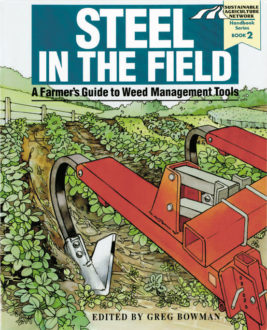Cultivation in Context: Renewed tools for better farming
Is MWC effective at controlling weeds?
How about in-row weeds and escapes in the “guess-row” area between planter passes?
MWC must be part of a weed management system. Because it deals with biological observation, crop stages and implement adjustments, mechanical weed control is an acquired skill. Farmers say it is art and science. They report that effectiveness of an integrated, mechanical-based weed strategy increases over time. Sustainable soil management brings gradual improvements year to year, and farmers learn new techniques.
The total effect becomes greater than the sum of the parts—fewer weeds in more mellow soil are out-maneuvered by synchronized crop rotations and disrupted by more expertly applied tillage or flaming. Close attention to fertility balance to lessen deficiencies and excesses gives crops more advantage. Narrower rows and precision seed placement increase the canopy effect.
In-row weeds deserve particular attention. Start early if you want to win. Management steps that hold weeds back in the days just after planting give crops a competitive advantage. When the crop is large enough to withstand soil flow, tools that move soil into the row can smother small, in-row weeds. This requires soil that “flows” and rows straight enough to keep cultivation speed high. Specialized in-row weeding tools developed originally for vegetables actually move between crop plants.
Is MWC dependable?
Wet fields, dry fields and schedule conflicts can hobble any weed control program. More options cover more contingencies. Sometimes cultivation can rescue a failed herbicide treatment. Other times a spot spray or postemergent herbicide pass can save a crop that remains too wet to cultivate.
Experienced farmers committed to mechanical weed control report they are no more vulnerable to economic losses from weeds than their neighbors with well managed herbicide programs. Some years they even fare better, but they would have a harder time guaranteeing a cosmetically perfect field, year after year.
Having the tool and labor capacity to cover crop acres within tight windows is a matter of weighing the odds then making a choice. Keep careful records on acres per day per tool and on hours per field. Figure the total time required compared with your average weather window. Scaling up tool capacity has to be a part of taking on more acres of the same crop with similar planting dates. Sequencing planting dates or changing crops are other options.
Wet years will come, but they don’t have to doom mechanical controls. Once you decide how small a cultivation time window you’re willing to work in, line up tools and drivers for the critical times. Emergency decisions are eased if you know the limits of your tools and the relative costs of weed-induced production losses. Marketing plans, weed characteristics and alternate crop use all play a part.
Is it unwise?
What about soil erosion, moisture loss or increased compaction?
Poorly managed tillage can cause these problems, as well as waste fossil fuel and harm crop growth. Mistakes include using the wrong tool or using the right tool at the wrong time, too often, in the wrong way, in the wrong place or at an improper orientation to field slope.
The general rule for MWC tillage is that it be as shallow, as infrequent, as specific to the weed problem, and as limited in soil impact as possible. Where following these guidelines still results in muddy water, dry root zones, damaged crop roots or compacted row areas, MWC is not appropriate as applied. You may seek assistance from an individual in your region or specialty from the “Contacts” list.
You make the difference by selecting the right tool and using it wisely. Occasional tillage—even moldboard plowing done properly—can actually decrease erosion by increasing moisture infiltration rates.
Cover crops, compost, manure and other organic matter incorporated into biologically active soil bring measurable changes. Properly managed, additional organic matter can increase infiltration and water-holding capacity, thereby reducing erosion potential.
A cultivation pass before a rain shower will have less impact where soil has greater tilth and soaks up more water. The same tool used the same way across the road on “tighter” soil will create channels and probably lead to more erosive water movement.
Where soil moisture is usually marginal, soil and residue disturbances should be minimized. Local soil types, precipitation patterns and crop systems give specialized weeding tools a role. Cases include shattering the soil crust after planting but before crop emergence, or intentionally creating a slightly compacted zone just under the soil surface to retain moisture.
A controlled traffic field plan (running equipment wheels in the same row middles season to season), using deep-rooted rotation crops and staying out of the field in wet conditions help to minimize compaction.
